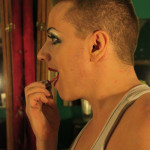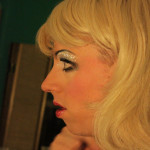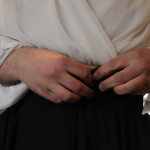These portraits of friends and strangers aim to reveal each individual’s unique way of challenging the gender binary, with a special focus on varied expressions of queer femininity. Some of the subjects live full time in a gender other than the one they were assigned at birth, some cross-dress in private, others break the gender binary within the context of their art. Is there any common ground between these types of experiences? Are they different degrees on the same continuum, or on the contrary do they stem from completely different needs or thought processes? In the case of performers, how does their ‘drag persona’ relate to their ‘civilian’ identity?
When looking for subjects in a crowd of strangers, I look for individuals whose body language express a desire to interact with me, be it in a dynamic of engagement, playfulness or provocation. When photographing people getting ready for performing, I start working as a discrete, neutral observer, and let them lead the dialogue in the way that suits their need of the moment, be it small talk, venting, or intimate confession, or ignore me if they prefer. By using this method, I aim for the subject to be in control of the photographer-subject dynamic, in the hope that the resulting images will provide snapshots of the subject’s mental state at the moment the picture was taken, rather a predetermined vision I may have had of them.
This project is concerned with individual experiences, in all their complexity, uniqueness and messiness, rather than with any kind of normalising theories.















